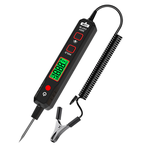Principles and precautions of noise tester
There are three standard weighting networks for frequency in noise meters: A, B, and C. The A network simulates the response of the human ear to a 40 square pure tone in an acoustic curve, and its noise meter curve shape is opposite to the 340 square acoustic curve, resulting in significant attenuation in the middle and low frequency bands of the electrical signal. B network simulates the response of the human ear to 70 square pure tones, which causes a certain attenuation in the low frequency range of electrical signals. The C network simulates the response of the human ear to 100 square tones, with a nearly flat response across the entire audio frequency range. The sound pressure level measured by a sound level meter through a frequency weighting network is called sound level. Depending on the weighting network used, it is referred to as A sound level, B sound level, and C sound level, with units denoted as dB (A), dB (B), and dB (C). The sound level meter used for measuring noise can be divided into four types of response based on sensitivity:
1. Slow down. The time constant of the meter head is 1000ms, which is generally used to measure steady-state noise, and the measured value is the effective value.
2. Hurry up. The time constant of the meter head is 125ms, which is generally used to measure unstable noise and transportation noise with large fluctuations. Fast gear approaches the human ear's response to sound.
3. Pulse or pulse hold. The rise time of the gauge needle is 35ms, used to measure pulse noise with longer duration, such as punch presses, hammers, etc. The measured value is the maximum effective value.
4. Peak retention. The rise time of the pointer is less than 20ms. Used to measure pulse sounds with short duration, such as guns, cannons, and explosions, the measured value is the peak value, i.e. the maximum value.
matters needing attention
1. Before use, read the instruction manual to understand the usage and precautions of the instrument.
2. Pay attention to the polarity when installing batteries or external power sources, and do not reverse the connection. If not in use for a long time, the battery should be removed to prevent leakage and damage to the instrument.
3. Do not disassemble the microphone to prevent it from being thrown or dropped, and place it properly when not in use.
4. The instrument should be avoided from being placed in places with high temperature, humidity, sewage, dust, and air or chemical gases containing high levels of hydrochloric acid and alkali.
5. Do not disassemble the instrument without authorization. If the instrument is not functioning properly, it can be sent to a repair unit or factory for maintenance.
6. Pay attention to waterproofing of the noise meter to prevent it from falling from high altitude.






